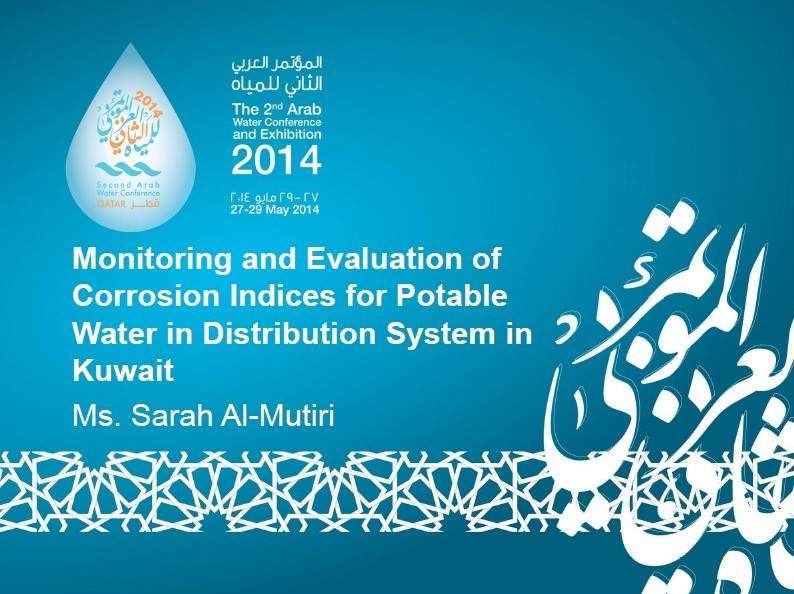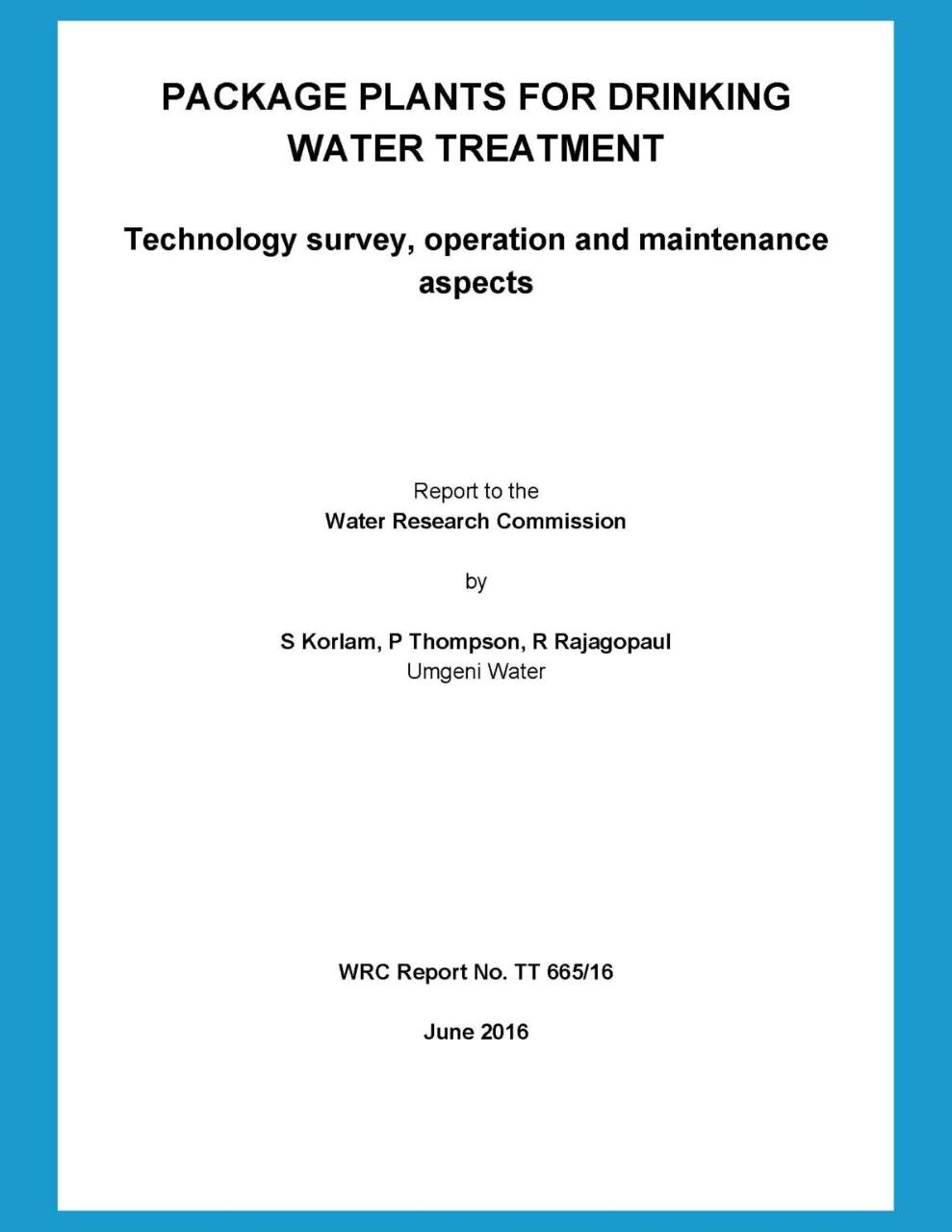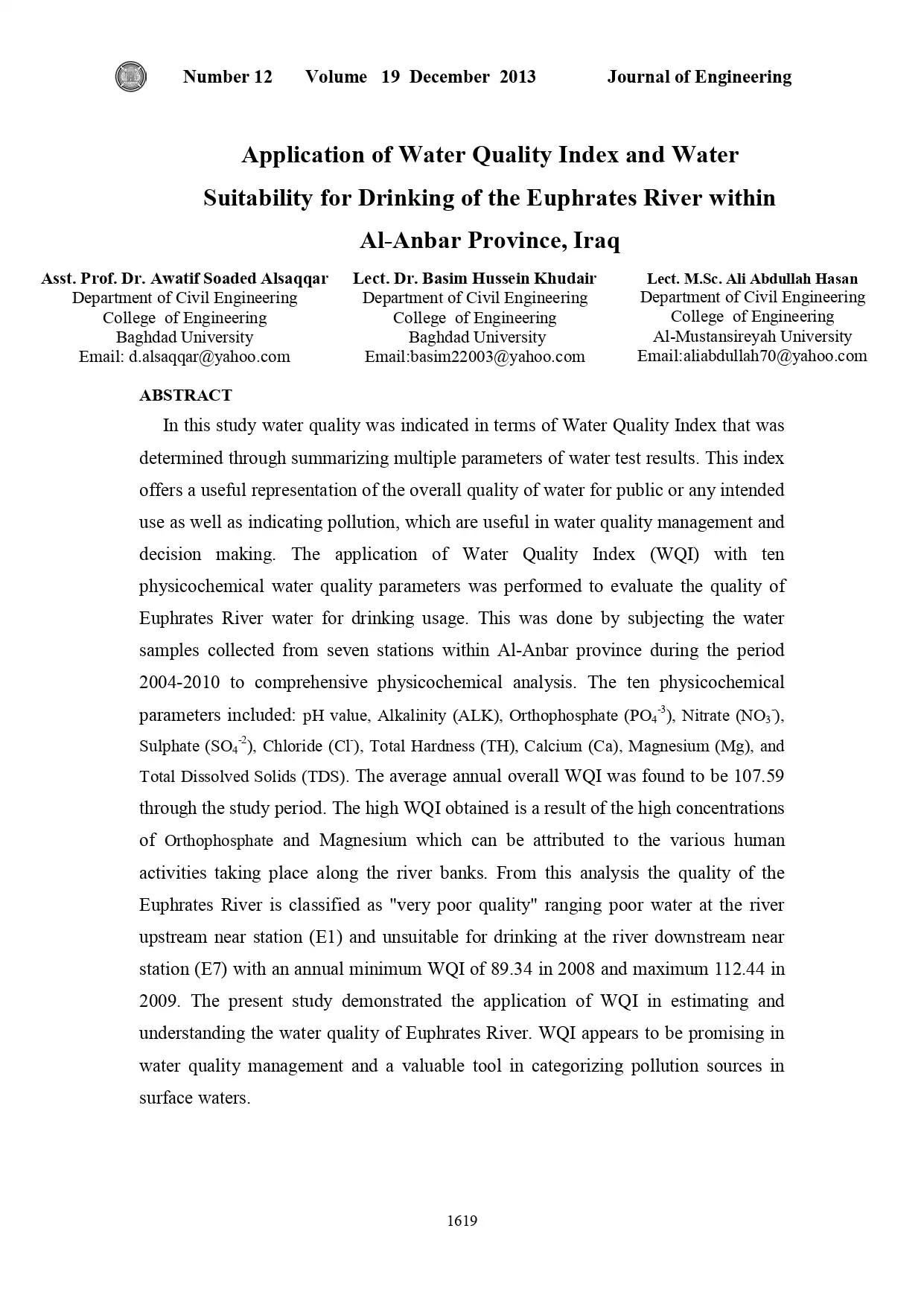Monitoring and Evaluation of Corrosion Indices for Potable Water in Distribution System in Kuwait
Monitoring and Evaluation of Corrosion Indices for Potable Water in Distribution System in Kuwait
Presented by: Sara Mohammed Al-Mutairi
Usually dispatched in 2 to 3 days
Usually dispatched in 2 to 3 days
Category:
Drinking Water Treatment
Only logged in customers who have purchased this product may leave a review.
Related products
Appropriate Technologies For Drinking Water Treatment In Mediterranean Countries
This paper aims at analyzing the drinking water issue in the Mediterranean region, highlighting the principal problems and the appropriate technologies applicable in the different countries. The countries of this area are characterized by a huge variety from social, cultural, economic and environmental point of view. In particular, water distribution is inhomogeneous between the North, East, and South; even the type of water sources and the related quantity and quality problems differ country by country. Potable water comes from brackish and seawater, surface water, groundwater and water reservoirs with each source face different issues. The main problem of brackish and seawater for example is the high salinity and the contamination by disinfection byproducts, in addition to the microbiological and chemical contamination due to human activities that characterize also other surface water sources. Groundwater is also affected by human activity and it is not exempted from salinity because of the water intrusion. Moreover, water reservoirs are often contaminated by seasonal algal blooms. Technologies applied for drinking water treatment vary country by country. The paper presents the main treatment processes
associated with the main water pollutants, according to the Mediterranean region. Case studies of drinking water treatment plants are also analyzed, presenting alternative technologies appropriate for specific contexts, among others. The characteristics of each specific context should be carefully analyzed in order to develop the most appropriate technologies; high-end technologies for drinking water treatment may not be applied equally to all countries or communities of the Mediterranean region.
Appropriate Technologies For Drinking Water Treatment In Mediterranean Countries
This paper aims at analyzing the drinking water issue in the Mediterranean region, highlighting the principal problems and the appropriate technologies applicable in the different countries. The countries of this area are characterized by a huge variety from social, cultural, economic and environmental point of view. In particular, water distribution is inhomogeneous between the North, East, and South; even the type of water sources and the related quantity and quality problems differ country by country. Potable water comes from brackish and seawater, surface water, groundwater and water reservoirs with each source face different issues. The main problem of brackish and seawater for example is the high salinity and the contamination by disinfection byproducts, in addition to the microbiological and chemical contamination due to human activities that characterize also other surface water sources. Groundwater is also affected by human activity and it is not exempted from salinity because of the water intrusion. Moreover, water reservoirs are often contaminated by seasonal algal blooms. Technologies applied for drinking water treatment vary country by country. The paper presents the main treatment processes
associated with the main water pollutants, according to the Mediterranean region. Case studies of drinking water treatment plants are also analyzed, presenting alternative technologies appropriate for specific contexts, among others. The characteristics of each specific context should be carefully analyzed in order to develop the most appropriate technologies; high-end technologies for drinking water treatment may not be applied equally to all countries or communities of the Mediterranean region.
Package Plants For Drinking Water Treatment
In efforts to make package plants more compact, affordable and easier to operate and maintain, it has been noted that the design and performance of some of these plants containing conventional treatment processes is sometimes compromised if technical expertise in this regard is lacking. Generally, there are several risks associated with poorly designed treatment systems, including loss of production, poor safety and compromised equipment and process unit efficiency with associated higher operating and maintenance costs. These risks have more severe consequences in the case of desalination (including water reclamation and water re-use) package plants. The objective of this project is to develop a set of guidelines to assist municipalities, water treatment practitioners, designers and package plant manufacturers in the specification and design of appropriate unit processes and operating parameters to fit the influent water quality, operating environment and other special treatment requirements.
Package Plants For Drinking Water Treatment
In efforts to make package plants more compact, affordable and easier to operate and maintain, it has been noted that the design and performance of some of these plants containing conventional treatment processes is sometimes compromised if technical expertise in this regard is lacking. Generally, there are several risks associated with poorly designed treatment systems, including loss of production, poor safety and compromised equipment and process unit efficiency with associated higher operating and maintenance costs. These risks have more severe consequences in the case of desalination (including water reclamation and water re-use) package plants. The objective of this project is to develop a set of guidelines to assist municipalities, water treatment practitioners, designers and package plant manufacturers in the specification and design of appropriate unit processes and operating parameters to fit the influent water quality, operating environment and other special treatment requirements.
Adsorbent Material Used In Water Treatment-A Review
Adsorption method of purify water relies mainly on the adsorbent to adsorb the impurities in the water, this paper introduces the latest research progress both at home and abroad, such as activated carbon, chitosan, zeolites, clay minerals plant-based, industrial waste . These adsorbent type will play a more and more important role in water treatment in the future.
Adsorbent Material Used In Water Treatment-A Review
Adsorption method of purify water relies mainly on the adsorbent to adsorb the impurities in the water, this paper introduces the latest research progress both at home and abroad, such as activated carbon, chitosan, zeolites, clay minerals plant-based, industrial waste . These adsorbent type will play a more and more important role in water treatment in the future.
Biofilm Control Study
Darigold operates a milk products facility in Lynden, Washington. Production processes include evaporation of milk, which generates what is referred to as condensate of whey (COW) water. COW water contains low molecular weight organic compounds including traces of lactic acid, alcohols, acetoin, and non-protein nitrogen (Möslang, 2017). COW water and non-contact cooling water from the Darigold Lynden facility are currently discharged to Outfall 001, which combines with stormwater and the City of Lynden’s wastewater treatment plant (WWTP) effluent discharge to the Nooksack River through the City’s outfall. Darigold’s discharge is regulated under National Pollutant Discharge Elimination System (NPDES) Permit No. WA0002470 administered by the Washington Department of Ecology (Ecology). In the future, Darigold’s COW Water and non-contact cooling water will be directly discharged to the Nooksack River in a new outfall pipe (Outfall 002) currently being constructed by the City.
Biofilm Control Study
Darigold operates a milk products facility in Lynden, Washington. Production processes include evaporation of milk, which generates what is referred to as condensate of whey (COW) water. COW water contains low molecular weight organic compounds including traces of lactic acid, alcohols, acetoin, and non-protein nitrogen (Möslang, 2017). COW water and non-contact cooling water from the Darigold Lynden facility are currently discharged to Outfall 001, which combines with stormwater and the City of Lynden’s wastewater treatment plant (WWTP) effluent discharge to the Nooksack River through the City’s outfall. Darigold’s discharge is regulated under National Pollutant Discharge Elimination System (NPDES) Permit No. WA0002470 administered by the Washington Department of Ecology (Ecology). In the future, Darigold’s COW Water and non-contact cooling water will be directly discharged to the Nooksack River in a new outfall pipe (Outfall 002) currently being constructed by the City.
Application of Water Quality Index and Water Suitability for Drinking of the Euphrates River within Al-Anbar Province, Iraq
In this study water quality was indicated in terms of Water Quality Index that was determined through summarizing multiple parameters of water test results. This index offers a useful representation of the overall quality of water for public or any intended use as well as indicating pollution, which are useful in water quality management and decision making. The application of Water Quality Index (WQI) with ten physicochemical water quality parameters was performed to evaluate the quality of Euphrates River water for drinking usage. This was done by subjecting the water samples collected from seven stations within Al-Anbar province during the period 2004-2010 to comprehensive physicochemical analysis.
Application of Water Quality Index and Water Suitability for Drinking of the Euphrates River within Al-Anbar Province, Iraq
In this study water quality was indicated in terms of Water Quality Index that was determined through summarizing multiple parameters of water test results. This index offers a useful representation of the overall quality of water for public or any intended use as well as indicating pollution, which are useful in water quality management and decision making. The application of Water Quality Index (WQI) with ten physicochemical water quality parameters was performed to evaluate the quality of Euphrates River water for drinking usage. This was done by subjecting the water samples collected from seven stations within Al-Anbar province during the period 2004-2010 to comprehensive physicochemical analysis.
An Energy-Efficient and Sustainable, Microbial Electrolysis- Deionization System for Salt and Organics Removal
The University of Tennessee, Knoxville (UTK) received funding from the Bureau of Reclamation (Reclamation) in September 2013 to investigate a novel salt and organic removal technology. Using microbial electrolysis cell (MEC) technology and salt removal via capacitive deionization (CDI) to remove organic compounds present in produced water was investigated. This project was conducted in collaboration with CAP Holdings Company (CHC), which provided expertise in CDI technology. Converting soluble organic compounds via MEC was coupled to salt removal via CDI, providing a proof of principle for synergistic salt and organic removal. Hydrogen was generated by MEC from organic compounds and used to produce renewable electricity via a polymer electrolyte membrane (PEM) fuel cell , which was then used to power the CDI cell to achieve deionization.
An Energy-Efficient and Sustainable, Microbial Electrolysis- Deionization System for Salt and Organics Removal
The University of Tennessee, Knoxville (UTK) received funding from the Bureau of Reclamation (Reclamation) in September 2013 to investigate a novel salt and organic removal technology. Using microbial electrolysis cell (MEC) technology and salt removal via capacitive deionization (CDI) to remove organic compounds present in produced water was investigated. This project was conducted in collaboration with CAP Holdings Company (CHC), which provided expertise in CDI technology. Converting soluble organic compounds via MEC was coupled to salt removal via CDI, providing a proof of principle for synergistic salt and organic removal. Hydrogen was generated by MEC from organic compounds and used to produce renewable electricity via a polymer electrolyte membrane (PEM) fuel cell , which was then used to power the CDI cell to achieve deionization.
Removal of Aluminium from Drinking Water
Aluminium in drinking water comes from natural sources and the alum used as coagulant in the water treatment process. Exposure to aluminium has been implicated in dialysis dementia, Parkinson and Alzheimer’s disease. Drinking water containing aluminium was considered to be one of the main sources of Al intake into human body. For this reason, the removal of aluminium from drinking water is vital to our health. In this study, removal of aluminium was carried out by using a chelating resin.
Removal of Aluminium from Drinking Water
Aluminium in drinking water comes from natural sources and the alum used as coagulant in the water treatment process. Exposure to aluminium has been implicated in dialysis dementia, Parkinson and Alzheimer’s disease. Drinking water containing aluminium was considered to be one of the main sources of Al intake into human body. For this reason, the removal of aluminium from drinking water is vital to our health. In this study, removal of aluminium was carried out by using a chelating resin.
Activated Carbon Treatment of Drinking Water
Introduction:
Activated carbon filtration (AC) is effective in reducing certain organic chemicals and chlorine in water. It can also reduce the quantity of lead in water although most lead-reducing systems use another filter medium in addition to carbon. Water is passed through granular or block carbon material to reduce toxic compounds as well as harmless taste- and odor-producing chemicals. This fact sheet discusses the principles and processes of typical activated carbon filtration systems.
Activated Carbon Treatment of Drinking Water
Introduction:
Activated carbon filtration (AC) is effective in reducing certain organic chemicals and chlorine in water. It can also reduce the quantity of lead in water although most lead-reducing systems use another filter medium in addition to carbon. Water is passed through granular or block carbon material to reduce toxic compounds as well as harmless taste- and odor-producing chemicals. This fact sheet discusses the principles and processes of typical activated carbon filtration systems.
Analysis of the Membrane Alternatives Suitable for Kvarnagården Water Treatment Plant.
In this study surveys to membrane manufacturers and water treatment plants regarding the performance of different membrane alternatives have been carried out from January to April 2012. The work has been done as a part of a study of the different membrane alternatives suitable for Kvarnagården Water Treatment Plant. Also in the study experiments regarding water quality parameters have been carried out at the water laboratory at Chalmers University of Technology. The project is carried out at the Department of Civil and Environmental Engineering and is connected to the company VIVAB, the company in charge of Kvarnagården Water Treatment Plant.
Analysis of the Membrane Alternatives Suitable for Kvarnagården Water Treatment Plant.
In this study surveys to membrane manufacturers and water treatment plants regarding the performance of different membrane alternatives have been carried out from January to April 2012. The work has been done as a part of a study of the different membrane alternatives suitable for Kvarnagården Water Treatment Plant. Also in the study experiments regarding water quality parameters have been carried out at the water laboratory at Chalmers University of Technology. The project is carried out at the Department of Civil and Environmental Engineering and is connected to the company VIVAB, the company in charge of Kvarnagården Water Treatment Plant.















Reviews
There are no reviews yet.